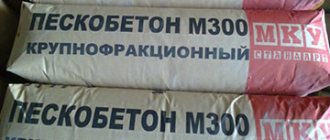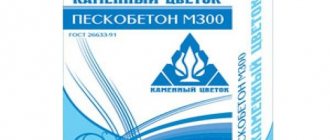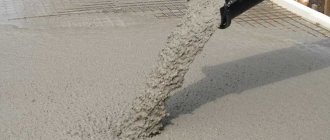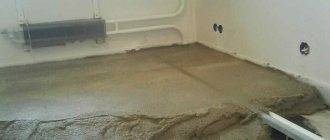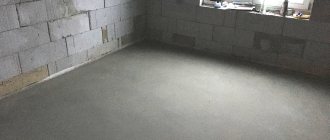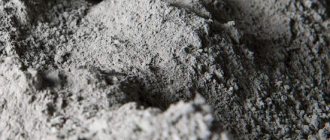Axton sand concrete is a dry building mixture intended for the production of concrete. The standard composition includes Portland cement and purified river quartz sand. The size of sand grains does not exceed 3 mm. To improve performance, various organic and mineral substances can be added to the material.
Axton - leader in building materials
The brand specializes in the production of various materials that have found their application in both professional and private construction. sand concrete is used for general work, in particular:
- arrangement of screeds;
- repair of any concrete surfaces;
- implementation of plastering works;
- concreting stairs;
- blind area device;
- construction of paths;
- block and brick laying;
- the mixture can be used as a mounting mortar when constructing foundations consisting of foundation blocks.
The material does not shrink and is characterized by decent strength characteristics. The finished surface is resistant to corrosion and temperature fluctuations
As you can see, the material is versatile and can be useful in private housing construction when carrying out interior and exterior work . A manual application method is provided.
Material consumption
To calculate the required amount of material, I will present data on the consumption of Axton sand concrete per 1 square meter. This material is often used for pouring foundations and high-quality screeds.
Consumption of 30 kg per 1 m2, depending on the planned thickness of the layer of 1-1.5 centimeters, will be from 20 to 30 kg. Accordingly, for a screed 2 centimeters thick, 40 kg of dry mixture will be required. When the area of the room is known, it will be easy to calculate the required amount of material. Thus, for a building of 150 m2 you will need approximately 150 bags of Axton sand concrete, 30 kg each.
It is generally accepted that a cheap screed can be made from ordinary cement mixed with sand. However, the quality of the mixture prepared at home is an order of magnitude inferior to sand concrete. The difference is in the composition; in the production of Axton sand concrete, sand of different fractions is used. The calculation of the ratios of particles of different sizes is carried out in such a way that the result is a durable surface that is not prone to shrinkage and cracking. It is impossible to prepare such a high-quality mixture on your own.
Consumption of M300 sand concrete per 1 m²
If we consider a material such as sand concrete, the consumption per 1 m² is within 34 kg, provided that the layer thickness is 20 mm . The construction mixture is supplied in bags weighing 30.0 kg.
It is worth noting that the mixture should be stored in closed production packaging, in a room with a moderate level of humidity, without contact with water, preferably on wooden pallets. If such conditions are met, the composition is stored for six months, starting from the date of production .
Characteristics
The mixture is made on the basis of Portland cement and quartz sand. Other characteristics are indicated in the table.
| Index | Norm |
| The basis | Cement |
| Color | Grey |
| Viability, no less | 120 min. |
| Setting period | 180 min. |
| Movement | After 48 hours |
| Maximum layer thickness | 100.0 mm |
| Minimum layer thickness | 8.0 mm |
| Ready for covering | After 48 hours |
| Compressive strength | After 28 days – 30.0 MPa |
| Peel strength (adhesion) | 0.50 MPa |
| Frost resistance cycles | 50 |
| min t of application | + 8 |
| max t application | + 30 |
Instructions for use
If the material is used in rooms with high humidity, there is no need for an additional waterproofing layer
The work is being carried out in stages, with strict adherence to the specified rules, according to the instructions.
The first stage is preparing the base:
- the surface gets rid of oil stains, dirt, dust, release agents;
- loose and weak areas should be removed;
- cracks and potholes are pre-treated using the same mixture;
- the base is covered with a strengthening primer, the layer must dry completely;
- If sand concrete is to be laid on a soil base, the surface should be compacted. To do this, a cushion of crushed stone and sand is laid, and the bottom layer of the poured mortar is reinforced.
The second stage is preparing the solution:
- pour the contents of the bag into a container filled with clean water while stirring constantly;
- one kilogram of dry mixture requires 0.16-0.20 liters of water. If Axton sand concrete is used, the water consumption per bag weighing 30 kg is 4.8 - 6 l;
- the mixture is mixed until uniform;
- mixing can be done manually or mechanically. To do this, it is advisable to use a drill with a special attachment;
- the mass is kept for 3-5 minutes, after which it is mixed again;
- sand concrete is ready for use.
An overdose of liquid leads to a deterioration in strength characteristics and the formation of cracks , that is, it is necessary to strictly observe (for Axton sand concrete 30 kg) water consumption.
The third stage - application scheme
Masonry:
- if brickwork is being done, the mortar is applied with a trowel or trowel.
Screed:
- the mixture is applied to the base using a shovel or trowel (the choice of tool is based on the required layer thickness);
- After the mixture is laid, the surface is leveled using the rule. For this purpose, special beacons can be placed. When leveling, it is necessary to ensure that there are no voids in the thickness of the solution;
- the time between laying and leveling should be reduced to a minimum;
- the freshly laid layer is protected from rapid drying, that is, the surface is covered with polyethylene film and wet sawdust for 72 hours;
- The room has not been ventilated for three days.
The clear advantage of sand concrete is its high plasticity and density, which allows the material to be used in any type of finishing work.
Application of Axton sand concrete
Sand concrete M300 successfully replaces conventional CFRP in the construction of concrete structures. It makes the work of builders easier and enhances the technical properties of the screed.
Scope of use
Brief characteristics of sand concrete M300:
- good ductility;
- resistance to corrosion;
- resistance to precipitation;
- strength;
- reasonable price.
The above technical parameters allow you to choose Axton when pouring strip foundations, where first-class strength is required. For the same reason, M300 is common when concreting industrial sites, flights of stairs, and pouring subfloors.
The scope of application depends on the fraction:
- Fine (up to 2 mm) perfectly replaces cement plaster. M300 is used for sealing seams and finishing work.
- The middle fraction (from 2 to 2.2 mm) has good thermal insulation properties and is indispensable as a basis for all kinds of floor coverings. They also produce paving slabs, curbs, and pedestrian paths.
- Large is used when pouring foundations. The mixture practically does not shrink, so it is used when working on unstable soils.
Axton brand hardened sand concrete is easy to process and is suitable for interior finishing work. Does not require additional waterproofing; it is used in the construction of utility rooms in private households.
You can buy the dry mixture in paper bags packaged in 25, 30, 40 and 50 kg. It is recommended to store the material, provided the packaging is intact, for no more than 6 months in a dry place.
Ingredients
Axton M300 is manufactured at enterprises using the latest technologies. During production, it is very important to follow the proportions verified by specialists so that the technical characteristics meet the standards.
Compound:
- Portland cement;
- sand;
- synthetic additives.
The main component is Portland cement, which is made from crushed clinker and gypsum. Various plasticizers, granite chips, and anti-corrosion ingredients are used as special additives.
Average consumption
Manufacturers indicate costs per 1 m2 on the packaging. Typically, the consumption of sand concrete per screed is 18-20 kg of powder with a layer thickness of 10 mm. If the surface has significant differences, then calculate the average layer thickness. To do this, measure the estimated height of the screed in several places in the room, including the highest. Based on the data obtained, the average value is found.
Axton consumption for bricks is 34 kg per 1 m2 (layer thickness 20 mm). The mixture will be required to fill the joints of the brickwork, so the consumption may exceed the standard rate. When working with a brick surface, it is advisable to purchase material with a reserve. Experts recommend applying a 20 mm thick compound to the floor slabs. The consumption indicated on the packaging must be doubled.
Filling the screed
Concrete is prepared in the following proportion: 120-130 g of clean water are added to 1 kg of dry Akston powder. All ingredients are thoroughly mixed until a homogeneous mass is formed. When mixing, strictly follow the manufacturer's recommendations, because excess moisture negatively affects the strength of the finished concrete. The resulting solution is kept for 10 minutes, and then they begin to work.
It is important to follow safety precautions, because when water and cement interact, an alkaline reaction occurs. In case of contact with eyes or skin, wash the affected area with plenty of water. If the need arises, consult a doctor.
The installation of a high-quality concrete screed is possible under the following conditions:
- the solution is applied to the cleaned surface within 3 hours after preparation;
- the air temperature in the workroom must exceed +5°C;
- get rid of high humidity using a water repellent;
- While the concrete is hardening, drafts are removed and windows and doors are tightly closed.
The screed takes about 7-10 days to fully set. The duration depends on the thickness of the layer, fraction, and room temperature. Complete hardening of the mixture occurs a month after pouring.
Cost of sand concrete M300
The material quickly earned excellent reviews from craftsmen because, despite its unique characteristics, it has an affordable price. You can buy it at any hardware store. But it is advisable to focus your choice not on the price of the product, but on the popularity of the brand.
| Brand M300 | Packaging, kg | Price, rubles per bag |
| Axton | 30 | 130 |
| Delux | 50 | 162 |
| FIX | 40 | 136 |
| Euromix | 40 | 165 |
| Dauer | 50 | 170 |
| Stone Flower | 25 | 128 |
Author: Valentin Tokarev
| Related articles: | |
| Advantages of Rusean brand sand concrete and its types Brands and characteristics of sand concrete Sand concrete brand LUIX - description and advantages | |
Reviews
Now we should consider what reviews the Axton brand (sand concrete) has earned among professional and private builders. Most craftsmen note that the material is of good quality, it does not curl or roll when applied and lies on the surface without much effort.
Working with him, according to reviews, does not create any discomfort. The building mixture meets the requirements of current standards, so the finished structures are durable, smooth, strong at an acceptable cost. The price of one bag (30 kg) is 97 rubles .
Comparative reviews and characteristics of axton sand concrete for creating a concrete floor screed are presented in the video:
Sand concrete AXTON reviews
Verified Purchase Review:
Wonderful sand concrete, we filled the hallway, kitchen and bathroom ourselves.
Everything is smooth, according to the level and beacons.) Name:
Sergey
Review:
Don’t overdo it with water and you will be happy.
If you want it to set faster, a little liquid glass in the water before kneading will help. If you don't moisten/cover it, it will crack. Pros:
Excellent concrete.
Convenient packaging. Competent instructions. Disadvantages:
Didn't see it.
Name:
Ilya
Review:
I took it in 5 kg bags.
Convenient portion for carrying and storage. And mix just in the basin. the solution is good. there is a lot of cement, the sand is very fine. The mixture mixes well even by hand. Advantages:
inexpensive.
Name:
Evgeniy
Review:
The screed turned out great - there are no cracks.
Advantages:
Excellent combination of price and quality.
Name:
Gennady
Review:
good sand concrete, used for screeding, homogeneous mixture
Advantages:
price, weight, quality.
Disadvantages:
none found
Name:
Elena
Review:
I bought it for pouring screed in a bathroom of 2.4 sq.m.
I read the reviews here, but decided to take a chance, maybe everything would be fine with me... But a miracle did not happen! After pouring, the screed immediately began to show small cracks, of which there were a lot! Fortunately, this is a bathtub and the tile adhesive will clog the cracks, but I don’t recommend this mixture for laminate flooring! Advantages:
I don’t know
Disadvantages:
the price is too high, the composition is not of good quality.
Name:
Alexey
Review:
I would like to add to my previous comment.
No advertising.. Just advice. There were 10 bags of this miracle of sand concrete left.. And I found an approach to it..: It does not tolerate drafts at all. Add a primer to the water..... and a plasticizer... And everything is super!!! You don't even need to cover it with film. The screed does not crack.. But it turns out to be expensive... I do not recommend it to beginners. Advantages:
Fine-grained.
Disadvantages:
Cracks. We need an approach.
Sand concrete M300 Axton 5 kg
Name:
Artem
Review:
The sand concrete is not bad, I was filling up a hole in the screed of the room. The patch turned out strong. It is necessary to mix strictly in the proportions of water. It dries quickly, which is a minus; leveling with a spatula is not very convenient. I also took sand concrete in a 30 kg package.... The quality is heaven and earth or I mixed it incorrectly from 30 kg or something else... It crumbles but in the 5 kg package it is very hard. Yes, and another sand is added there..... In general, if you don’t need a lot, take it in a 5 kg package.
Name:
Artyom
Review:
I used it to fill a hole under a threshold on a balcony, it’s strong and reliable
Advantages:
one bag was enough to fill a hole under a threshold
Disadvantages:
I didn’t find any
Name:
Dima
Review:
if you get used to it, it’s quite tolerable
Advantages:
price
Disadvantages:
dries out too quickly, crumbles
Name:
Andrey
Review:
Convenient, durable packaging.
Disadvantages:
Essentially it is sand and some cement. After drying, crumble by hand.
Name:
Igor Chashchin Employee of Leroy Merlin Kievskoe Shosse
Review:
Convenient to carry - put it in a backpack and it’s ready.
Doesn't get dirty. I used it to seal cracks in the floor - it hardens well, there is little dust. Advantages:
Ease of transportation.
It sets well. Little dust. Disadvantages:
None found.
Name:
German
Review:
I laid the bricks, took them apart in the morning, and the mortar all crumbled into sand.
Advantages:
there is sand
Disadvantages:
almost no cement, adhesion, strength
